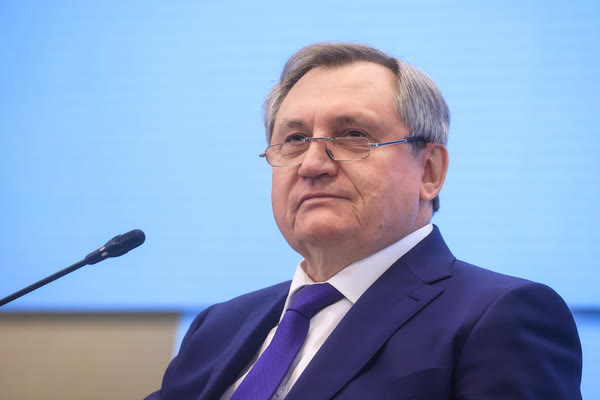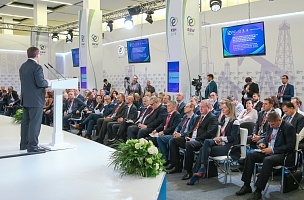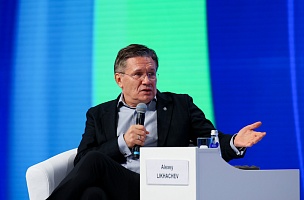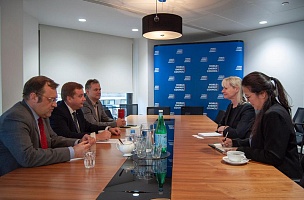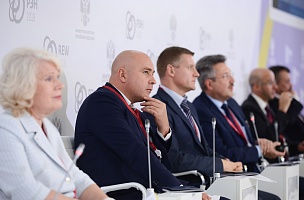Key conclusions
Dynamic development of Russia’s electric power industry
“Our consumers should not be concerned about the condition of our electric power industry. There is nothing to be concerned about the preparation for the autumn and winter or about the fuel inventory, water resources, or repairs. Energy consumption is rising. As of today, the growth rate is 2.5%. This consumption growth in ensured by an adequate energy generation level. We keep working and closely watch all the global trends,” Nikolay Shulginov, Minister of Energy of the Russian Federation.
“Electric power industry always finds itself in the time of change, because there are constant changes in consumption and generation driven by new technologies. As for generation, last year it grew 5.5% year-over-year. This year, it continues to be on the rise despite all the geopolitical events. At the same time, Russia’s energy system is the largest in terms of coverage. Regional composition is also important, when it comes to growing demand. For example, energy consumption in Kuban Territory grew 11% last year, which is related among other things to consumer behaviour, tourism and wide-spread use of air conditioning,” Fedor Opadchiy, Chairman of the Board, System Operator of the United Power System.
Import substitution potential in Russia’s electric power industry
“Hydro power generation is among the most protected industries in terms of technological sovereignty, because it is a fairly old industry. Hydro power design and research institutes exist and develop to this day. We have preserved all Soviet competencies. We have trusts that are almost 100 years old – they are the hydro power generation trusts. Our major equipment is supply by our long-standing partners, such as Power Machines. These large facilities have their own research and practical cluster and they keep developing. New facilities appear as well,” Viktor Khmarin, Chairman of the Management Board, General Director, RusHydro.
“It is the question of operation. We have analyzed our emergency stock. I know it for a fact that for the next two years we are fully covered in terms of emergency stock and operating our major equipment. <…> Our share of imported [equipment, – Ed.] is not high. We have been up to import substitution for a while now. In terms of new purchases, it is about 10%. It means that Russian equipment make 90% of cumulative equipment,” Andrey Ryumin, General Director, Chairman of the Management Board, Rosseti.
PROBLEMS
Uneven load and use of electric grid
“Excess capacities. We know that it is an existing problem. We have a large number of consumers that do not use their capacities to the full. It happens so that 60, 70 or even 80% of capacity is not used by the consumer. At the same time, the rest of the consumers pay for the operation of this infrastructure. When it comes to new construction, we do not redistribute the capacities. So, we build additional infrastructural and electric grid facilities. Yet again, consumers pay for it,” Andrey Ryumin, General Director, Chairman of the Management Board, Rosseti.
“We believe that the presence of the electric energy system and its sustainability, as well as the price forecastability are among the most important factors for making decisions on future projects. Big industrial capacities depend on the source. There are projects that have never been designed or launched, because their potential locations did not have energy supply. Generally, if you look at this equation, you need capacities, you need the grid and you need a large consumer,” Dmitry Konov, Member of the Council, Russian Chemists Union.
Real electric energy tariffs are hard to make
“Residential tariffs [are regulated, – Ed.] by the government. The principle of cross-regulation is still used to keep the tariffs below the inflation rate. In concerns consumers, investors, and small and medium businesses that intend to join the federal grid and do not increase the net supply in their territory. It drives the tariffs up at the low voltage level. It is an eternal fight, which needs to be over,” Nikolay Shulginov, Minister of Energy of the Russian Federation.
“The choice between reliability and excessive financial burden is always present. Currently, there is an evident problem – the inflation rate does not cover all the existing tariff solutions. Moreover, underregulating also exists. This is why the government needs to help the electric power industry. <...> There are government decisions on discounted credits for the too-big-to-fail facilities in the electric power industry, but as far as I know not a single one of them managed to get hold of them. As for the electric grid, the existing tariffs do not match the present economic situation,” Alexey Texler, Governor of Chelyabinsk Region.
SOLUTIONS
Development of renewable energy
“As for energy generation, the trend for reducing carbon footprint remains. The development of renewable energy – the solar and wind energy – raises a number of important questions for the energy system on integrating those volumes. As of today, the sun and the wind provide southern nuclear power plants with up to 300 MW of internal generation rebalancing for the appropriate generation sources. <…> There are plans to increase the share of the solar and wind energy in the energy generation composition. We see that we will have to initiate a major development of the electric grid – first of all, the inter-system grid – a search for potential sources of the electric system flexibility,” Fedor Opadchiy, Chairman of the Board, System Operator of the United Power System.
“We see significant changes in the technologies that efficiently reduce the cost of other renewable energy sources. This is why we have adopted a programme to develop solar and wind energy generation in the next eight years, with 10% of expected energy generation being not generated by hydro power plants. It will mostly be solar and wind energy. We have determined four projects where we would like to attract direct foreign investments and we will keep working to make it happen,” Daler Juma, Minister of Energy and Water Resources of the Republic of Tajikistan.
Completing import substitution in Russia’s electric power industry
“One of the tasks I see for now is to active contribute to import substitution. We are actively working towards this goal. We have facilities that I think are world-class. Today, we are working on the energy storage system and power distribution transformers. Inverters, converters to DC, AC and reverse current are pure import substitution, which we are actively involved in. We are also involved in fast-charging stations. A few years ago, we installed one in Chelyabinsk, and the number of electric cars increased significantly,” Alexey Texler, Governor of Chelyabinsk Region.
“There are two solutions. First of all, it is domestic production. The second one is re-designing, applying other technical solutions that will enable the transition to domestic equipment. It may be 2–3 years, during which just Russian production facilities will completely replace the entire line of imported equipment. <...> A good option is for large companies to cooperate, become an anchor customer and show a common demand <...> for manufacturers. Then it will be easier and clearer for manufacturers to set up some production lines. They will understand the volume of the market, the volume of demand they see,” Andrey Ryumin, General Director, Chairman of the Management Board, Rosseti.
For more information, visit the Roscongress Foundation’s Information and Analytical System atroscongress.org.


